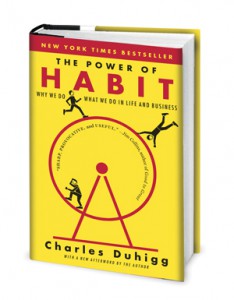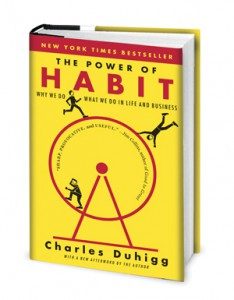I recently completed reading ‘The Power of Habit‘ by Charles Duhigg. This is the 19th book I’ve read this year.
Major take-away: We all have the power to change our lives and it starts with understanding how habits work. The quick secret formula? There isn’t one. There are thousands, and it all depends on the situation. Focus on the cue | routine | reward.
How habits emerge within individual lives – The first section focused on how habits emerge within individual lives. It explores the neurology of habit formation, how to build new habits and change old ones, and the methods. For instance, that one ad man used to push toothbrushing from an obscure practice into a national obsessions. It shows how Procter & Gamble turned a spray named Febreze into a $billion business by taking advantage of consumers’ habitual urges, how Alcoholics Anonymous reforms lives by attacking habits at the core of addiction, and how coach Tony Dungy reversed the fortunes of the worst team in the NFL by focusing on his players’ automatic reaction to subtle on-field cues.
Habits of successful companies and organizations – This section details how an executive named Paul O’Neill – before he became treasury secretary- remade a struggling aluminum manufacturer into the top performer in the Dow Jones Industrial Average by focusing on one keystone habit, and how Starbucks turned a high school dropout into a top manager by instilling habits designed to strengthen his willpower. It describes why even the most talented surgeons can make catastrophic mistakes when a hospital’s organizational habits go awry.
Habits of societies – This section recounts how Martin Luther King, Jr., and the civil rights movement succeeded, in part, by changing the ingrained social habits of Montgomery, Alabama – and why a similar focus helped a young pastor named Rick Warren build the nation’s largest church in Saddleback Valley, CA.
Case studies:
Febreze – It all started with a chemist at P&G who didn’t like his clothes smelling like an ashtray after smoking playing around with HPBCD in a laboratory. The company spent millions perfecting the formula, finally producing a colorless, odorless liquid that could wipe out any foul order. The science behind it was super advanced.
Drake Stimson was leading the marketing efforts and nearly on the brink of failure… all he had to do was figure out how to make Febreze into a habit. He was a 31 year old wunderkind with a background in math and psychology. Before joining P&G, he had spent five years on Wall Street building mathematical models for choosing stocks.
Over a few months, Stimson and his team studied people in hundreds of households, in a few test markets – Phoenix, Salt Lake City and Boise. Their first breakthrough was when they visited a park ranger in Phoenix, who always smelled like a skunk (her clothes, her house, her truck) and wanted to be free of that terrible smell.
Stimson went back to headquarters and positioned Febreze as something that would allow people to rid themselves of embarrassing smells. They designed two television commercials. The first focused on smoking, with a woman telling her friend to use Febreze to eliminate the odor. The cue: smell of cigarettes. The reward: odor eliminated from clothes. The second ad featured a woman worrying about her dog, who is always on the couch and the woman then smells like the dog. The cue: pet smells, which are familiar to seventy million households with animals. The reward: a house that doesn’t smell like a kennel.
The year was 1996 when the ads were pushed out. They gave away samples, put advertisements in mailboxes, and paid grocers to build mountains of Febreze near cash registers. After two months, sales were awful. Febreze was a dud! Even one of the executives was ready to pull the plug on it and cut their losses.
A new team of PhD researchers joined Stimson and started doing more interviews. Quickly they realized that the product’s cue – the thing that was supposed to trigger daily use – was hidden from people who needed it most. The woman with 9 cats was desensitized to the smell of all those cats. Smokers don’t realize how bad the smell is. Bad scents simply weren’t noticed frequently enough to trigger a regular habit.
After some time, they asked a Harvard Business School professor to conduct psychological tests of Febreze’s ad campaigns. The interviewed customer after customer, looking for something that would give them a clue on how to make Febreze a regular part of consumers’ lives.
One day, they went to speak with a woman in a suburb near Scottsdale. She was in her forties with four kids. Her house was clean, but not compulsory tidy. To the surprise of the researchers, she loved Febreze. “I use it everyday,” she told them. She had no pets. No one smoked. The house didn’t seem like the kind of place that had smelly problems. To their surprise, she used it as a final touch – that one spray after cleaning. To her, spraying felt like a mini-celebration after cleaning a room.
After they got back to headquarters, they started analyzing the videos of hundreds of tests. One researcher pointed out that consistently they are doing something relaxing or happy when they finish cleaning. What if Febreze was something that happened at the end of the cleaning routing rather than the beginning? What if it was the fun part of making something cleaner?
Stimson’s team ran one more test. Previously, the products advertising had focused on eliminating bad smells. They printed up new labels, added some perfume to the bottle so it had its own unique fragrance, etc. Then, each ad was calibrated to elicit a craving; that things will smell as nice as they look when the cleaning ritual is done. The irony is that a product manufactured to destroy odors was transformed into the opposite. The park ranger with the skunk problem had led them down the wrong road… who really wants to admit their house stinks? No one!
The Febreze relaunch took place in the summer of 1998. Within a years, customers had spent more than $230 million on the product. Since then, Febreze has created numerous spin-offs – air freshness, candles, laundry detergents, etc. Combined, those products account for $1billion per year in sales.
Source: The Power of Habit by Charles Duhigg
Target – How Targets what. you want before you do
Andrew Pole, a data expert/statistician was asked, “Can your computers figure out which customers are pregnant, even they don’t want us to know.? For companies, pregnant woman are gold mines!
Have you ever thought about the marketing tactics in retail spaces?
- Why fruits and vegetables are first? Because you are more prone to buy all the junk food after you’ve felt good about having the healthy stuff.
- Ever notice that cereal is often random? It’s to confuse you so you’ll get that one good box yet grab the naughty box loaded with sugar.
- Why majority of people turn right when entering? This is where retailers know to put the highest margin $ products.
Starting a little over a decade ago, Target began building a vast data warehouse that assigned every shopper a unique “Guest ID number” – that kept tabs on how each person shopped. When a customer used a Target-issued credit card, handed over a frequent-buyer tag at the register, redeemed a coupon, used the Target app, etc. the company’s computers took note. Also linked to that was demographic information that Target collected or purchased from other firms, including the shoppers age, whether they were married and had kids, which part of town they lived in, etc.
Long story short, Pole’s computer program crawled through the data and he was able to identify about twenty-five different products that, when analyzed together, allowed him to, in a sense, peer inside a woman’s womb. Most important, he could guess which trimester she was in – and estimate her due data – so Target could send her coupons when she was on the brink of making new purchases.
To not scare women off, they creatively mixed random products in to create an illusion that its just that – random. Today, many are still oblivious to all of this – whether it’s Target, Home Depot, Best Buy, etc.
Data is BIG business.
In fact, the company I work for Acuity Brands has positioned itself as a leader in the IoT space with our advanced indoor positioning technology that is used in Target stores. Read article here.

